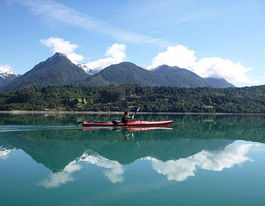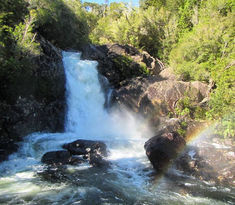5 things to say in your Kayak Safety Talk
- Jacynthe Boudreau

- Jun 12, 2018
- 6 min read

You are going out for a kayaking excursion or expedition
with clients or with some friends that have no experience
in sea kayaking?
Make sure you make a nice safety talk
to put them confidents about the trip and your expertise.
It will avoid you some trouble or panic reaction
en case the weather change or the currents increase.
Presentation:
Be sure you present yourself properly to your group. Greating them at their arrival, telling your name and making a small resume of what will be your itinerary in kayak today is a good way to make your clients confident about the development of the outdoor activity they are about to start.
2. Hand out the equipment:
We will provide a neoprene wetsuit and booties that fits every participant.
Question: Please let me know what your shoes size and general size is such as S-M- L-XL. Does everyone have a rain jacket and warmer clothing for the day? Considering that the weather may change or vary during our activity.
Provide PFD / Life jacket and a spray skirt, showing how to wear it and making the necessary adjustments.
If your clients are using a dry suit that belong to you or the company, help them to put it on or to close it properly. Some clients may wear rings, earrings or other jewelry that may damage the neck or wrist seal gasket. Once a gasket is broken, it becomes a dangerous item, plus the replacement of the seal may be complicated and costly.
There is a whistle attached to each PFD. We will only use it to get your attention quickly, in case of emergency, to give important security information or if somebody is navigating too far from the group and we need them to come back closer.
So, if you hear a whistle blowing, look to your guide, he is probably trying to tell you something. If you cannot hear him properly, get close to him as quickly as possible.
Important: if you hear the whistle making long repetitive sounds this means there is an emergency. Look for your guide, get close to the group and follow all of the instructions that the guide will give you.

3. Kayak Adjustments:
After asking if the participants have used a kayak with rudder before, explain how it works. It is easy:
We first need to adjust the rudder pedals to the person steering the kayak, the person in a single kayak or the person sitting in the back of the double kayak.
How does the rudder work?
To put it in or out of the water, there is a rope on the side of the cockpit.
The basics are simple: once sitting, if you want to turn left, you push the left-side pedal, and if you want to turn right, you push the right-side pedal. Always paddle on both sides of the kayak, and the faster you paddle, the faster you turn.
To adjust the pedals to your height, you need to sit in your cockpit with your back straight and give a slight bend to your knees, so you are more stable and have more control of the rudder.
Most of the time, you keep the pedals centered, and only press them softly to turn. The only times you push them to the maximum is if you would like to make a full turn. The rudder works very efficiently so small movements will already change your direction.

4. Tips for efficient paddling:
How to use the paddle:
Holding the paddle: make sure that you can read the paddle's brand, that way you make sure you are paddling with the active blade of the paddle.
The small gaskets that are on the shaft of your paddle are there to keep water from running down and dripping on your hands. You should adjust them near the paddles.
Forward propulsion:
To find the right position for where to put your hands on the paddle, put your hands a little more than shoulder width apart, in line with the middle of your paddle , hold it up near your face and bend your elbows at 90°, keeping your wrists in line with your elbows.
Once you have your hands in position, keep your arms extended, with a micro bend in your elbows. The effort should come from your abdomen making a rotation of your core, not from your elbows or biceps.
When you make your stroke, introduce completely the white part of your paddle into the water, entering where your feet are. Move it towards you but no further back than your hip. Movements further back than your hips, can be bad for your shoulders and may result in injury.
When you are paddling, you should have the front arm fully extended, and the back arm with a very small bend at the elbow. Make sure you are pushing with your front arm, and not just pulling with the back arm. This way you will help divide the effort and be more efficient
Double kayaks
Double kayaks bring a lot of advantages for beginners:
They are very stable, even in big waves or in presence of strong winds.
They allow you to take pictures and make videos during your activity.
They are faster than individual kayaks, so you will need less strength and you will be less tired at the end of the day.
Only the person sitting in the back of the boat will have the control of the direction through the rudder.
In a double kayak, the ideal technique is for the two participants to paddle on the same side at the same time. The person sitting in the back time their rhythm with that of the person sitting in front. That way, your propulsion will have a better inertia and you will avoid colliding paddlesbetween the two partners.
However, if the 2 participants cannot seem to find the same rhythm: ¨DON’T WORRY; RELAX AND ENJOY¨ Avoid fights with your partner, it is much more important that both have a good time, you will still reach your destination! It is important to have a good communication during the navigation.
5. When things go wrong: What to do in a Capsizing situation
How to avoid capsizing:
First, capsizing is not very common.
Most 50% of capsizing events occur when getting in or out of the kayak fromthe shore. The best way to avoid this is to keep your center of gravity low, and have someone help you stabilize your boat while you are entering.
About 40% of capsizing happen due to careless movements or playing around. Common examples are throwing water at your friend with your paddle, racing,or trying to push someone as a joke and not reaching him....
First remember to always maintain a proper sitting position in the kayak and pay attention to the waves/water conditions.
Basically, avoid all sudden movement and take it slow at the beginning.
If you encounter big waves, stay calm and paddle on! You will stabilize yourself by paddling, either forward or backward. You can also try putting your paddle flat on the water for additional support.
If you do Capsize:
Our guide will explain the procedure before entering the water to ensure that everyone understands the protocol in the event of capsizing. Remember this normally doesn’t happen, but as a safety precaution we always give this small instruction before going to sea.
First, the group must stay together during this maneuver and listen to your guide’s instructions.
Once you capsize and hit the water, the spray skirt should come loose by itselfthanks to the water pressure. If for any reason this doesn't happen, lift your knee to push it out. And if this is now working you can always run your hand around the edge of the spray skirt until you find the handle and pull it out. Then, get out of the kayak!
If you are in a double kayak, check to see if your partner is also out. If he is not, give him a hand.
Hold on to your paddle as well as your kayak, as those are your best floating devices.
The guide will quickly come to you and take your paddle, so you will not lose it and will have both hands free. Once he holds your kayak, swim over to the front of his kayak and hold on there. At this point please be patient as he will need time and space to empty the water from your kayak.
Next, the guide will empty your kayak and place it parallel to his own. When he tells you to, go back to your cockpit. While he holds on to your kayak, he will give you a count of three to get back in. You will do this by facing the rudder and getting on the kayak staying on your belly, then put your legs in, and once you are in, turn around and take your seat again. Remember to keep your center of gravity low, never standing up during this maneuver.

For more information or for guided tours
in the Lake District Patagonia Chile, reach us:
San Jose 192, Oficina #203, Puerto Varas, Región de Los Lagos Chile
info@jasspuertovaras.com +56 9 65906458



























Comments